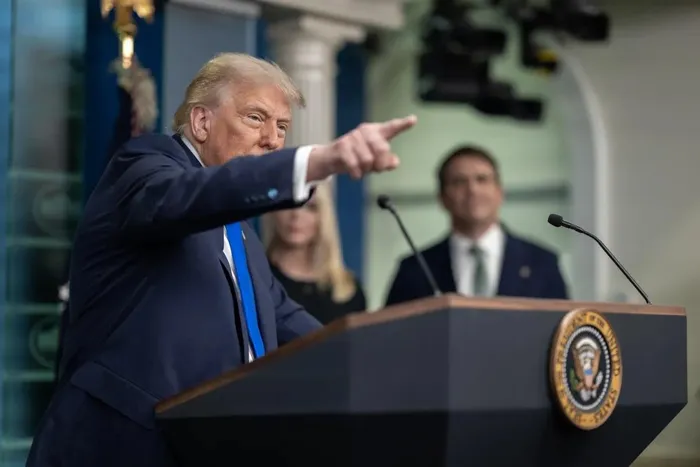Rand fairly stable after Trump tariff shock in early morning trade Tuesday

US President Donald Trump imposes 30% tariffs on South Africa.
Image: White House
The rand weakened marginally overnight after US President Donald Trump slapped South Africa with 30% tariffs on goods exported to America, based on an alleged trade imbalance, although there may be more volatility to come.
Having reached R17.73 at 5pm South African time on Monday, it dropped 0.7% as Trump made his shocking announcement in the US. However, by 6am Tuesday morning, it had recovered to R17.79, suggesting that markets had mostly priced in a resumption of tariffs ahead of Trump’s initial July 9 deadline.

South Africa's rand weakened marginally overnight on Tuesday after Trump imposed 30% tariffs.
Image: Wise.com
Trump, who has vacillated in terms of taxes and trade deals, initially announced a 30% trade duty on South Africa’s exports on his so-called “Liberation Day” on April 2 before walking back his move in response to a massive hit on US markets.
Having then decided that import taxes would stay at 10% for 90 days, he has been negotiating trade deals with several countries, although only China, the UK, and Vietnam had inked agreements as of last week. South Africa has failed to sign a deal so far.
Trump has taken particular umbrage with countries in the BRICS bloc, having said on his social media platform, Truth Social, that countries “aligning themselves with the Anti-American policies of BRICS, will be charged an ADDITIONAL 10% Tariff. There will be no exceptions to this policy.”
Old Mutual chief economist, Johann Els, said that Trump’s decision to impose 30% tariffs on all South African exports to the US, excluding precious metals is “contrary to expectations after President [Cyril] Ramaphosa's White House visit and comes as a disappointment.”.
In a voice note shared at 10pm, Els added that “even though it will have a negative impact on South Africa's economy in terms of GDP growth, I think to a large extent the impact has been priced in since the April 2 announcement of “Liberation Day” tariffs.”
Els added that less than 8% of South Africa's exports goes to the US. “I suspect that some of our exporters have already found some alternative export markets. Nevertheless, it is a negative and it will impact negatively on sentiment, even though some of it might have been priced in.”
Trump, who has vacillated in terms of taxes and trade deals, initially announced a 30% trade duty on South Africa’s exports on his so-called “Liberation Day” on April 2 before walking back his move in response to a massive hit on US markets.
Having then decided that import taxes would stay at 10% for 90 days, he has been negotiating trade deals with several countries, although only China, the UK, and Vietnam had inked agreements as of last week. South Africa has failed to sign a deal so far.
Trump has taken particular umbrage with countries in the BRICS bloc, having said on his social media platform, Truth Social, that countries “aligning themselves with the Anti-American policies of BRICS, will be charged an ADDITIONAL 10% Tariff. There will be no exceptions to this policy.”
Old Mutual chief economist, Johann Els, said that Trump’s decision to impose 30% tariffs on all South African exports to the US, excluding precious metals is “is contrary to expectations after President [Cyril] Ramaphosa's White House visit and comes as a disappointment”.
In a voice note shared at 10pm, Els added that “even though it will have a negative impact on South Africa's economy in terms of GDP growth, I think to a large extent the impact has been priced in since the April 2 announcement of “Liberation Day” tariffs.”
Els added that less than 8% of South Africa's exports goes to the US. “I suspect that some of our exporters have already found some alternative export markets. Nevertheless, it is a negative and it will impact negatively on sentiment, even though some of it might have been priced in.”
On Monday, Wichard Cilliers, director & head of market risk at TreasuryONE, noted that the rand and Indian rupee were the weakest performers in EM FX on the day “as renewed tariff threats from Trump targeted BRICS countries”.
Cilliers said that Trump’s pledge to impose an additional 10% tariff on nations aligning with "Anti-American BRICS policies" rattled sentiment just days before the expiry of the current 90-day tariff pause. “Volatility indicators ticked higher, suggesting that traders are bracing for more swings in the weeks ahead, especially as Brazil and South Africa remain far from concluding trade deals with the US,” he said.
Annabel Bishop, Investec chief economist, said on Monday that after nearing the key resistance level of R17.50 last week on US dollar weakness, increased uncertainty has seen the dollar rebound ahead of US tariff decisions, pulling the rand weaker to R17.72 as of lunch on Monday. She added that “market risk aversion rose from Friday, seeing some volatility,” as many countries had not yet signed deals.
Bishop noted that the rand has weakened against other major currencies as well, given that global risk is seen to have escalated, with the rand at R20.92 against the euro as on midday Monday from R20.59 EUR last week, while the local currency dropped to R24.23 against the pound from R23.92 last week.
Trump has also warned that if South Africa were to retaliate by raising its own tariffs, those would be matched and added to by Washington. “Whatever the number you choose to raise them by, will be added onto the 30% that we charge,” on official White House stationary.
The S&P declined 0.79% following the announcement. The JSE closed 0.19% up yesterday, although any effect from the news will only be seen from about 9am.
IOL